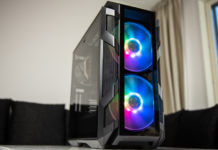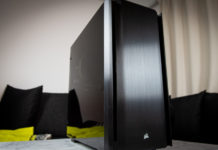The Antec Performance One series is one of the most praised series of cases you can find. In this review we take a look at the latest addition in the form of P182 Limited Edition and investigate if it can live up to the good reputation of the series.
When Antec entered the case market it was accused of making Chieftec copies and offering little innovation.
The fact they used the same factory was established and never really doubted, but Antec had no intention of being a follower. It didn’t take long before it started building more distinct cases offering both decent cooling and stylish design. Some of the most popular so far include the PlusView II, Super LANBOY, Sonata and SLK AMB/AMG
series.
Antec didn’t settle for just offering good cases though, they aimed for being the best and the next step toward that was to launch the Performance One series. Today, this series contains three models;
P150, P180 and P182. Yet another model is on the way and we will take a closer look at that one in the future. Today we will take a look at a Special Edition of the P182, namely Antec Performance One P182SE.
Performance One P182 introduced some features the older P180 lacked.
These contributions include pre-made and rubber-coated holes for drawing water cooling tubes through and keep the radiator on the outside, and better control of the fans. The one thing that makes the case a true Special Edition is the polished mirror surfaces and a snake light.
On the coming pages we will take a closer look at this case, which offers quite a lot of ingenious features.
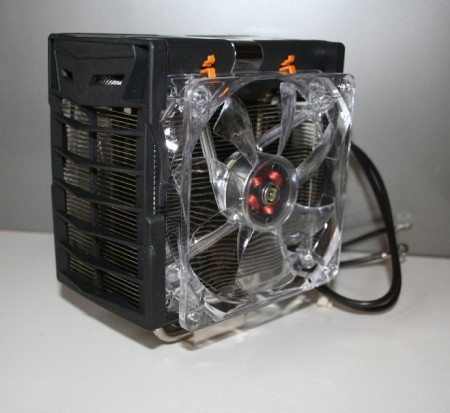 |
|
|
Antec Performance One P182 Special Edition
|
|
| Case: | Miditower |
| Side panel: | Mirror finish |
| Measurements (HxWxD): | 52 x 21x 51cm |
| Weight: | 14.4kg (17.4kg gross) |
| Motherboard support : | mATX, ATX |
| Cooling: | Rear – 120mm Roof – 120mm Lower chamber – 120mm Front – 120mm (not included) Upper harddrives – 120mm (not included) |
| Material: | Side panels made from aluminum and plastic Frame made from 0.8mm stainless Japanese steel |
| Internal units: | 6×3,5” |
| External units: | 4×5,25” 1×3,5” |
| Expansion slots: | 7 |
| Power supply | – |
| Other: | Detachable harddrive cages FireWire, USB, mic and headphone connectors in the front Compartment for storing screws, etc.. Two-chamber design Rubber dampening throughout the case Holes for drawing water tubes through Tons of screws and extra brackets for the harddrives, optical units and fans. Removable and washable dust filters Removable dust filter holder for the top fan Cable ties Microfiber cloth Snake light Manual |
Antec Performance One P182 Special Edition is a miditower, size larger. As you can see in the table above, it supports the regular motherboard sizes and has room and mounts for more fans than usual with cases of this size. These fans are all strategically placed, which we will discuss later on in the article.
The case is delivered with three 120mm fans installed: one in the roof of the case, one in the rear and one in the lower chamber. These are all adjustable in three different modes. You also have the possibility to install a few more fans, as you will see on the coming pages. The specifications of the fans are in the table below. We recommend you to set them to the lower possible setting. That is because it’s more than enough and the faster settings are a bit too loud for our taste, even if it may sound a bit fastidious.
The number of 5.25” and 3.25” slots is pretty normal for cases of this size and we can’t imagine that you would need more for a regular computer.
| RPM |
Airflow
|
Noise
|
Power
|
| 2000RPM |
79CFM
|
30dB(A)
|
2,9W
|
| 1600RPM |
56CFM
|
28dB(A)
|
2,4W
|
| 1200RPM |
39CFM
|
25dB(A)
|
1,6W
|
The side panels of the P18X series are made from three layers (aluminum – plastic – aluminum) that dampen practically all of the noise and vibrations coming from the components. At the same time, we have a rigid frame made from stainless Japanese steel. Aluminum is too soft to be used as frame material and the superior heat conductive properties does not outweigh the drawbacks of more vibrations and a soft frame.
 Accessories |
The manual contains more than plenty of information on how to install every possible component, but also how the cooling of the case works. It even contains information about how the USB, FireWire and sound connectors are constructed. Other manufacturers should follow Antec’s example, because all too many motherboards have been short-circuited because of bad pin diagrams and poorly connected USB and firewire ports.
The exterior of the Special Edition is the most distinct difference from the regular P182. It namely comes with a mirror finish. You know those kind of surfaces that have a tendency to attract fingerprints just by someone looking at them? That’s the one. In our opinion they are really nice, but we’re not sure if we dare to touch the case, in risk of leaving prints. Mixed feelings of anxiety and despair gathers.
On the one hand, it’s not that often you actually have to come in contact with the case after having installed all of the hardware. Antec anticipated this though and sent along a stylish, black microfiber cloth for those who want to keep the side panels clean of fingerprints.
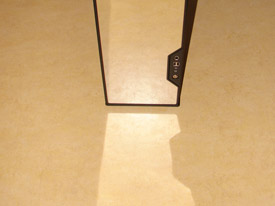 |
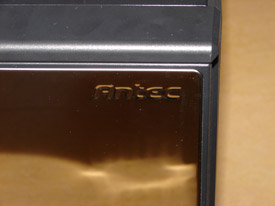 |
As you can see on the pictures it’s not just the sides that have a mirror finish, but also the front. There is probably a much greater chance of fingerprints ending up there than on the sides, but that’s what you have your Antec microfiber cloth for. Nothing to get upset about. Below you can spot the two fan locations in the front of the case (left) and the strategically placed USB, Firewire and sound connectors (right).
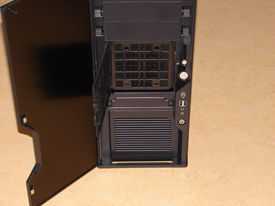 |
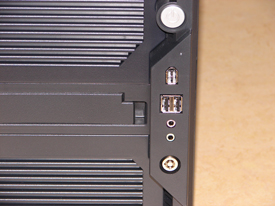 |
On the rear, we can see that the power supply is placed in the lower portion of the case, just like the other P18X models, and that Antec has equipped the case with a 120mm fan in the rear, which is adjustable in three different modes. At the top of the back side we can see two small controls for setting the modes of the two fans in the upper chamber. The door of previous P18X models have been harshly criticized, but this is just a mere memory now. P182 Special Edition comes with a sturdier door that closes properly and remains closed. Also, it doesn’t have the bending phenomena the first door suffered from.
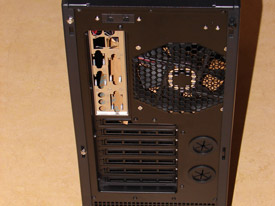 |
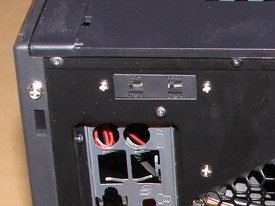 |
A bit down and to the right we can see the two holes that makes the case a lot better suited for water cooling. These holes make it possible to place the radiator, but also other parts of the water cooling, outside of the case. The P18X series has been accused of being too tight and crowded to be used for water cooling, but this has now been remedied.
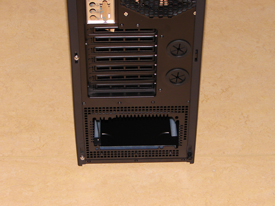 |
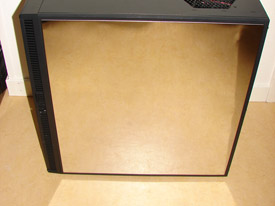 |
If you take a closer look at the picture to the left above you can also see that Antec has switched the metal brackets covering the expansion holes. The new ones have holes, instead of covering the slots entirely and shutting in the air. Although, this is an area where there are two different teachings. Some prefer a closed system with a strict and regulated airflow, while others don’t mind having air leaking from such holes.
The inside is what has made the P18X series such a huge success. Antec has designed a two-chamber system, where the lower chamber contains the power supply and room for four harddrives, which are cooled by a pre-installed 120mm fan (TriMode). The harddrive cage is tightly fitted, but not too tight, in the front of the case. It’s quite easy to draw the cables, although the holes could’ve been a bit bigger. It’s not the most fun to draw PATA cables, but that is also why they should be killed off right away, I do mean that from the very bottom of my heart.
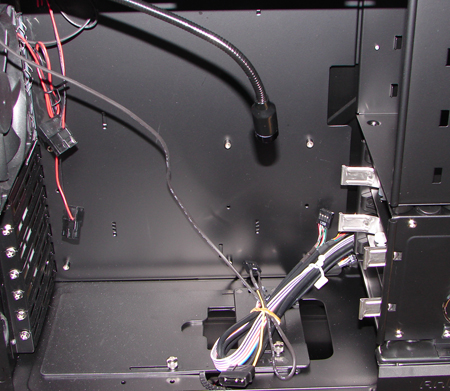 |
In the roof of the case you will find a so called snake light. This is a light with a flexible and adjustable arm that you can bend and twist pretty much any way you like. It’s powered either by a 4-pin molex connector or a USB connector on the motherboard. You can use it even when the system is powered off and need some help in the dark. When you’re done you slide it back into the roof holder. If you don’t like it, don’t use it. You won’t even notice it when it’s folded back.
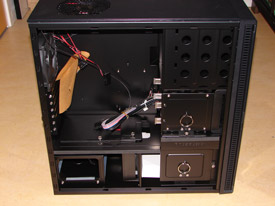 |
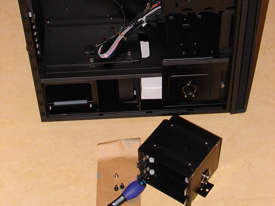 |
In the lower and rear position we have the holder for the power supply. The power supply is not just screwed in place, but first fitted into a holder with rubber dampening, which have been improved since the last model and now absorbs all of the vibrations. The case has been constructed so that you can draw the cables up and behind the motherboard plate. That is, if the cables are long enough, but if they are we truly recommend you to do so. It may take some time, but it’s quite easy and result is just fabulous. Between the power supply and the harddrive case we find the previously mentioned fan for cooling the harddrives.
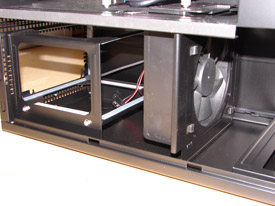 |
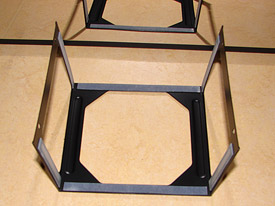 |
You will find most of the goodies in the upper chamber, especially after everything has been installed. In the roof of the case there is a 120mm can and in the back there is another. As we mentioned on the previous page, both of these can be controlled through controls on the back of the case. Clean, stylish and convenient.
Below you can see the two harddrive cages and their varying design. The upper cage namely holds two harddrives, with two sleds that are "in the cage" already. The screws for attaching the harddrives goes in from beneath, instead of from the sides. The lower cage has a more traditional design where the disks are simply screwed in place from the sides of the cage. All holes have rubber dampenings. Make sure to turn the cage so that the thicker rubber dampenings are on the down side when you slide the cage back in it’s place.
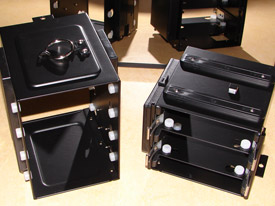 |
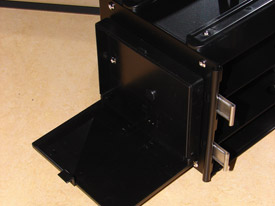 |
The upper cage can also be equipped with an extra fan (not shown) for those who want to cool their graphics card a bit extra. This is only possible if the cage is empty. The basic idea is that the cage will act as a wind tunnel, drawing air from the outside, and after some minor testing, we have to conclude that it seems to be working. Our tests with a Radeon X1600 Pro during load, with and without a 120mm fan moving 40cfm, showed a difference of several centigrade degrees. Using even faster graphics card there should be an even bigger difference, so a strategic PC builder has a lot to gain from placing the harddrives in the lower chamber and use the wind tunnel effect for the graphics card.
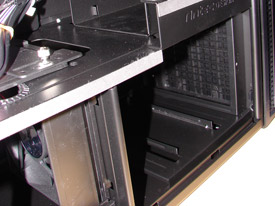 |
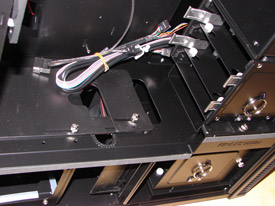 |
On the rear of the upper cage there is a small container where you can keep screws and other things, so you don’t have to bring a separate box for these things. A really convenient solution if you use it. Less convenient if you think you have, travel through half of Sweden, start assembling your computer at DreamHack and realize that the screws are still in your toolbox back home. You can send an e-mail to our editor in chief if you want to know more about this, because I’m till laughing too hard to be able to tell the full story.
In front of the upper harddrive cage there is room for another 120mm fan. Above it we can see the four 5.25" slots, which all have a "protecting" piece of metal on the inside. We recommend you to remove these to eliminate any possible and rather unnecessary vibrations.
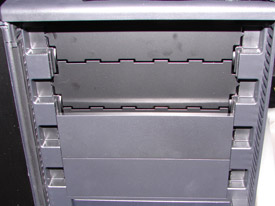 |
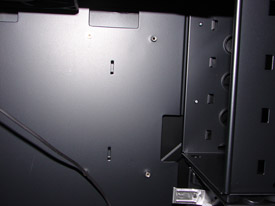 |
We can see a couple of big holes in the motherboard plate and they are for drawing the cables behind and around the motherboard, thus removing any unnecessary obstruction of the airflow. There is also the big bonus of a clean interior. Compared to previous versions there are more and larger holes, but it seems that the previous versions will be updated in a similar manner.
What can you say about case like this one? The fundamentals were laid out together the users and the experts of the cooling and noise-hating community. The goal has been a silent and cool case with an optimized airflow. We dare to say that Antec has succeeded.
The overall design leaves little to complain about. The Special Edition has mirror panels which made butterflies appear in this author’s belly when he removed the protective plastic. Even if he knew that fingerprints would be all over the case pretty fast he couldn’t help feeling a bit excited.
At the first touch and when lifting the case out of the box you could feel the sturdy structure, a distinction of a quality case. It was rigid, yet not clumsy nor too heavy. The controls for the fans are easy to access, Antec has added holes for water cooling tubes and the connectors on the front are also very convenient, but they are on the other hand very common today. Thanks to to the pin diagrams in the manual you won’t have to worry about connecting the connectors wrong. Last but not least, the door has been improved and behaves the way it should.
The interior of the case is even better. I’ve already praised it so much, I’m going to settle for saying that the layout is really good. The harddrive cages are seated just tight enough, all screw holes have rubber dampenings to kill any possible vibrations and the three fans can be set to three different modes. There is every possibility for a PC builder to assemble a really cool and at the same time quiet computer. The only thing that might feel a bit lengthy is that you have to remove the opposite side panel to mount the power supply, but since you have to remove it anyway to draw the cables behind the motherboard, it’s not something we’re going to hold against the case in this review.
We should add that it will take longer to assemble a computer using this case than some other boring run of the mill case, but the result is like comparing American Budweiser to sweet Czech lager. Both are malt beverages and the latter may take a bit longer to consume, but then it also tastes so much better. Or a Lada to a Lexus, if you’re not into malt beverages.
The one thing we’re ambivalent about is the snake light. It’s not extremely easy to work with during the first assembly, but during a LAN or a similar situation it is worth a lot more. I certainly wouldn’t complain if someone handed in a case with a built-in light to our support at DreamHack.
Antec Performance One P182 Special Edition is probably the best case I’ve ever had the pleasure of working with. To make you understand the size of that statement, I should mention that I’m the chief of the hardware support at DreamHack, an event that attracts close to 10,000 people, which means that I have been working with pretty much any case you can imagine, for better and for worse, especially for worse. There are cases from Silverstone, Chieftec Lian-Li and CoolerMaster that are all of very high quality, but I have never bumped into any case with such few flaws as P182. It seems that this baby costs a bit more than $200, which is a lot of money to spend on a case, but this is a top notch case. On the other hand, there are the P180 and P182 which both cost little more than half of the Special Edition, I can recommend both of them. They are quite similar, but lacks the mirror panels, which may even be an advantage for some, or even esthetical preference. We on the other hand, love ’em.
 |
|
Antec Performance One P182 Special Edition
|
|
Pros + The cable arrangement possibilities Cons |
We’ve chosen to award the Editor’s choice to Antec Performance One P182 Special Edition.

Antec Performance One P182 Special Edition
We want to thank Antec for supplying us with this sample.












